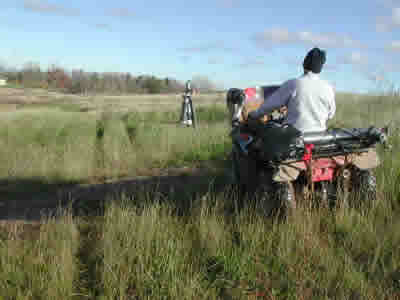I-CORP INTERNATIONAL, Ocean Ridge, FL, and Apogee Scientific, Littleton, CO, have formed a strategic alliance to provide infrared spectroscopy methane/CO2/CO gas surveys to locate leaks in landfill geomembrane caps, particularly those that do not lend themselves to the conventional electrical leak location survey technology. The IR gas monitoring technology can also be used for rapid LFG surveys on landfill caps to meet NSPDS regulations.
 |
| Survey tracks about 5 ft apart. Mounted on an SUV or an ATV, continuous surveys can be made at speeds up to 10 mph, measuring gas concentrations (<1 ppm) as a function of location which is determined simultaneously by GPS. |
With general leak plumes/sources identified, the location of maximum gas concentration can be then pinpointed by hand probe surveys. Depending on topography, comprehensive surveys on parallel tracks about 5 ft apart can cover 15 to 30 acres per day, approximately 10 times faster than conventional electrical surveys that cover about 2 acres per day. Where conduit, ditches, and roads may divert gas pathways before they reach the surface, the hand-operated equipment can be used to quickly guide excavation to the actual source of the leak.
 |
| Linear methane concentration peak over cap seam |
The technique will also be applicable to some bottom liner surveys consisting of geocomposite only between two geomembrane liners where conventional electrical surveys require the leak detection system to be backfilled with water. This is time consuming, costly, sometimes stressful on the liner, and slopes cannot be surveyed. If a characteristic gas such as sulfur hexafluoride can be introduced between the geomembranes, a gas survey detecting parts per billion can be performed, again covering over 20 acres per day.
For large area single liners, such as for wastewater treatment ponds, evaporation ponds, and heap leach pad liners, the possibility exists for placing a non-damaging chemical on the subgrade that will slowly release a characteristic gas for locating leaks after the first layer of cover soil has been placed.
Two 15 acre cap projects locating 9 and 30 leaks have been completed in just over 1 day.
 |
| Leak locations circled and GPS track on segment of cap surveyed adjacent to uncapped active cell |
For more information, please contact Ian Peggs.











